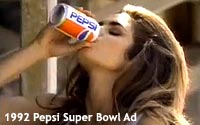 There are not only a record number
of advertisers showing their Super Bowl ads early, but there are a heck of a lot of them using celebrities. Combine the two, and you can get an unscientific gauge of which celebrity ads are working
and which are not based on views on the brands' YouTube channels.
There are not only a record number
of advertisers showing their Super Bowl ads early, but there are a heck of a lot of them using celebrities. Combine the two, and you can get an unscientific gauge of which celebrity ads are working
and which are not based on views on the brands' YouTube channels.
Acura's ad with Jerry Seinfeld and Jay Leno (and the Acura NSX concept) has garnered over 7.6 million views as of Thursday
morning; sibling Honda's CR-V ad with Matthew Broderick has gotten 8.5 million; H&M Bodywear ad with David Beckham, 600,000 give or take, so far. Bridgestone's ad with sportscaster Dick Vitale has
1.5 million views; Pepsi Max's ad with Regis Philbin got 113,186 views; Century 21's ad with Deion Sanders, Trump, and Apollo Ohno has gotten 6,205 views.
advertisement
advertisement
That's a good mix with high numbers,
at least online. But non-celeb ads have done well, too, with Audi's vampire ad getting 2.2 million views so far. Is it worth the risk? In Honda and in Acura's case, maybe. But media research firm Ace
Metrix says that last year, ads without celebrities performed 9.2% better than those with them.
Last year, the only ad starring a celebrity that ranked within Ace Metrix's Top 10 Most
Effective Super Bowl Ads was the Snickers ad with Rosanne Barr and Richard Lewis. Among the 10 least-effective Super Bowl ads last year were five that starred celebrities, including Groupon's ad
starring Timothy Hutton, Lipton Iced Tea’s ad starring Eminem, GoDaddy’s ad starring Joan Rivers, Salesforce.com’s ad starring Will.i.am, and Stella Artois' ad staring Adrien
Brody.
Lee Garfinkel, chief creative officer of global brands at Euro RSCG Worldwide, knows the drill. When he was at BBDO, he penned the Pepsi ad starring supermodel Cindy Crawford that ended
up rated as one of the best ads of the 1992 Super Bowl and one of the best-ever Pepsi spots.
He tells Marketing Daily that the key is content and concept. "Without that, putting a
celebrity in an ad is a recipe for disaster," he says. In his famous Pepsi spot, Crawford drives into a gas station in a Ferrari and strolls over to a machine, drops a coin and gets a can of Pepsi. As
she drinks it lustily, a couple of farm kids lean on a fence dumbstruck with admiration ... for Pepsi's redesigned can. "But the same year, Michael Jordan was in the Bugs Bunny ad, which put us at
number two. Both were great conceptual ways of using celebrities," he says.
Garfinkel isn't so bullish on the Richard Lewis ad for Snicker's last year because Lewis' character was softened up.
"You could tell that the clients said, 'We don't want him to be so manic.' Why hire him if you are going to water him down?"
What about Eminem and Chrysler? Ace Metrix put it at
fifth-most-effective auto ad in last year's Super Bowl. It garnered a 591 Ace Score, above the industry norm of 525.
Peter Daboll, CEO of Ace Metrix, says that while the Super Bowl is a great
medium in which to build iconography, there are inherent problems with big-name personages: celebrities are polarizing. "People either love or hate them, so you cut off a big chunk of the audience --
those people just don't like that person," he says, adding that the second big issue is relevance. "What are they in the ad for? Do they add something?"
Daboll tells Marketing Daily
that last year's Chrysler ad featuring rapper Eminem worked because the star wasn't the focus of the ad -- Detroit and Chrysler were. "You don't see him until the very end of the commercial, which was
very graphic, beautifully shot in black and white. And he kind of represents Detroit."
The other obvious problem is the potential for the celebrity to efface the brand, product and message,
says Daboll. "People must be able to recall what's being advertised. We have seen examples where people thought the ad was hilarious but the dreaded question is, 'Who is that for again?' I think you
will see the same type of ad for GoDaddy you see time and time again, which lives up to what not to do. It's very polarizing, kind of juvenile humor.”
The firm says ads with animals
performed 21% better than ads with celebrities, and were 14% more effective than the average non-animal Super Bowl ad.